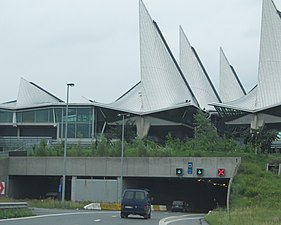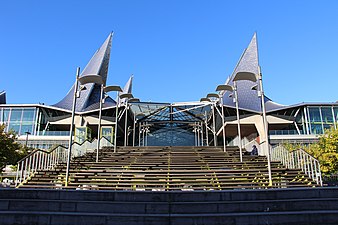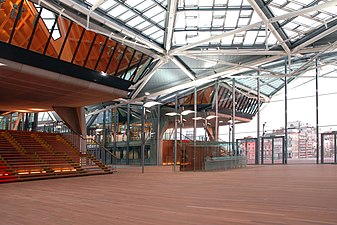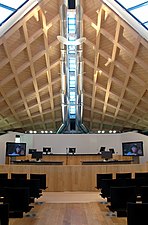
The Palais de Justice, is a judicial center and courthouse in Paris, located on the Île de la Cité. It contains the Court of Appeal of Paris, the busiest appellate court in France, and France's highest court for ordinary cases, the Court of Cassation. It formerly housed the Tribunal de grande instance de Paris which was relocated in 2018 to a new high-rise building in Paris's Batignolles neighborhood. The Palais de Justice occupies a large part of the medieval Palais de la Cité, the former royal palace of the Kings of France, which also includes Sainte Chapelle, the royal chapel, and the Conciergerie, a notorious former prison, which operated from 1380 to 1914. It is located in close proximity to the Tribunal of Commerce, the Prefecture of Police of Paris, and the offices of the Paris Bar Association.

The Palais Bourbon is the meeting place of the National Assembly, the lower legislative chamber of the French Parliament. It is located in the 7th arrondissement of Paris, on the Rive Gauche of the Seine, across from the Place de la Concorde.

The Royal Courts of Justice, commonly called the Law Courts, is a court building in Westminster which houses the High Court and Court of Appeal of England and Wales. The High Court also sits on circuit and in other major cities. Designed by George Edmund Street, who died before it was completed, it is a large grey stone edifice in the Victorian Gothic Revival style built in the 1870s and opened by Queen Victoria in 1882. It is one of the largest courts in Europe. It is a Grade I listed building.
Peter Rice was an Irish structural engineer. Born in Dublin, he grew up in 52 Castle Road, Dundalk in County Louth, and spent his childhood between the town of Dundalk, and the villages of Gyles' Quay and Inniskeen. He was educated at Queen's University of Belfast where he received his primary degree, and spent a year at Imperial College London. Rice acted as Structural Engineer on three of the most important architectural works of the 20th century: the Sydney Opera House, Pompidou Centre and the Lloyd's Building and was renowned for his innate ability to act as both engineer and designer.
Arup is a British multinational professional services firm headquartered in London that provides design, engineering, architecture, planning, and advisory services across every aspect of the built environment. It employs about 17,000 people in over 90 offices across 35 countries, and has participated in projects in over 160 countries.

The Palace of Justice of Brussels or Law Courts of Brussels is a courthouse in Brussels, Belgium. It is the country's most important court building, seat of the judicial arrondissement of Brussels, as well as of several courts and tribunals, including the Court of Cassation, the Court of Assizes, the Court of Appeal of Brussels, the Tribunal of First Instance of Brussels, and the Bar Association of Brussels.

Antwerpen-Centraal railway station, officially Antwerpen-Centraal, is the main railway station in Antwerp, Belgium. The station is operated by the National Railway Company of Belgium (NMBS/SNCB).

The palace of the Counts of Poitou/Dukes of Aquitaine in Poitiers in Poitou in western France is a medieval testimony of the Plantagenet style of architecture.
The Zuid ("South") in Antwerp is a currently fashionable area of Antwerp. Revived in the mid-1980s, it has an attractive street plan and a few Art Nouveau buildings, such as the former Volkshuis on the Volkstraat, but which now houses the Rudolf Steiner school. Three museums, numerous commercial art galleries, fashionable cafes and restaurants, two arts' centres and a sprinkling of up-market shops add to the attractions of the area.
The Oosterweel Link is a construction project first proposed in 1996, intended to complete the R1 Antwerp Ring Road in Antwerp, Belgium. The firm Antwerp Mobility Management Company, is the Flemish Government controlled organisation assigned responsibility for the project. The Oosterweel link will connect the Expressweg (E34) near Blokkersdijk via a toll tunnel underneath the Scheldt, leading to a dual-layered tunnel under the Albert Canal and connecting with the Antwerp Ring Road at Merksem and Deurne.
Royal BAM Group nv is a Dutch construction-services business with headquarters in Bunnik, Netherlands. It is the largest construction company based on revenue in the Netherlands.

The Palais de la Cité, located on the Île de la Cité in the Seine River in the centre of Paris, is a major historic building that was the residence of the Kings of France from the sixth century until the 14th century, and has been the center of the French justice system ever since, thus often referred to as the Palais de Justice. From the 14th century until the French Revolution, it was the headquarters of the Parlement of Paris. During the Revolution it served as a courthouse and prison, where Marie Antoinette and other prisoners were held and tried by the Revolutionary Tribunal. Since the early 1800s it has been the seat of the Tribunal de grande instance de Paris, the Court of Appeal of Paris, and the Court of Cassation. The first of these moved to another Parisian location in 2018, while the other two jurisdictions remain located in the Palais de la Cité as of 2022.

The United States Courthouse, also known as the Federal Building, is a historic building located in Davenport, Iowa, United States. It has historically housed a post office, courthouse, and other offices of the United States government. The building now serves only as a federal courthouse, housing operations of the eastern division of the United States District Court for the Southern District of Iowa. In 2018, the operations of the Rock Island division of the United States District Court for the Central District of Illinois were also moved there.

Minshull Street Crown Court is a complex of court buildings on Minshull Street in Manchester. The court was designated a Grade II* listed building on 3 October 1974.

Antwerp is the largest city in Belgium by area at 204.51 km2 (78.96 sq mi) and the capital of Antwerp Province in the Flemish Region. With a population of 530,504, it is the most populous municipality in Belgium, and with a metropolitan population of around 1,200,000 people, it is the second-largest metropolitan region in Belgium, second only to Brussels.

The Palais de Justice of Strasbourg is a large 19th-century neo-Greek building in the Tribunal quarter of the Neustadt district of Strasbourg, France, which houses Strasbourg's main court, the Tribunal de Grande Instance.

The Tribunal judiciaire de Paris, located at the Judicial Campus of Paris in Batignolles, is the largest court in France by caseload. It replaced the capital's former Tribunal de grande instance and Tribunal d'instance under an amalgamation of jurisdictions that came into effect on January 1, 2020.

The Palais de la Cour de Justice is a building complex acting as the seat of the Court of Justice of the European Union (CJEU), located in the European district of the Luxembourg City quarter of Kirchberg. Today the Palais complex encompasses the original 1973 building, now known as the Ancien Palais, which houses the court rooms of the CJEU's Court of Justice, the Anneau building, encircling the Ancien Palais, which contains the judges chambers and deliberative rooms, the three tower buildings containing the CJEU's translation services, and the Gallery building, containing the CJEU's legal library and linking all the structures of the Palais complex with the renovated three annexes originally constructed between 1978 and 1994 that now host the court rooms of the CJEU's General Court.

The High Court of Australia building is located on the shore of Lake Burley Griffin in Canberra's Parliamentary Triangle. It is currently the home to the High Court of Australia. The High Court building was designed between 1972 and 1974 by the Australian architect Christopher Kringas (1936–1975), a director of the firm Edwards Madigan Torzillo and Briggs. The building was constructed from 1975 to 1980. Its international architectural significance is recognised by the Union of International Architects register of 'Architectural Heritage of the 20th Century'. It received the Australian Institute of Architects 'Canberra Medallion' in 1980 and the award for 'Enduring Architecture' in 2007. The High Court building was added to the Commonwealth Heritage List in 2004.

The Tribunal de commerce de Paris, until 1968 Tribunal de commerce de la Seine, refers both to the tribunal de commerce of Paris, a commercial court, and to the building that hosts it on the Île de la Cité in Paris. Because that building's main entrance is on the quai de la Corse, the phrase Quai de la Corse is used as a nickname for the court, not least with reference to its role in corporate insolvencies.































